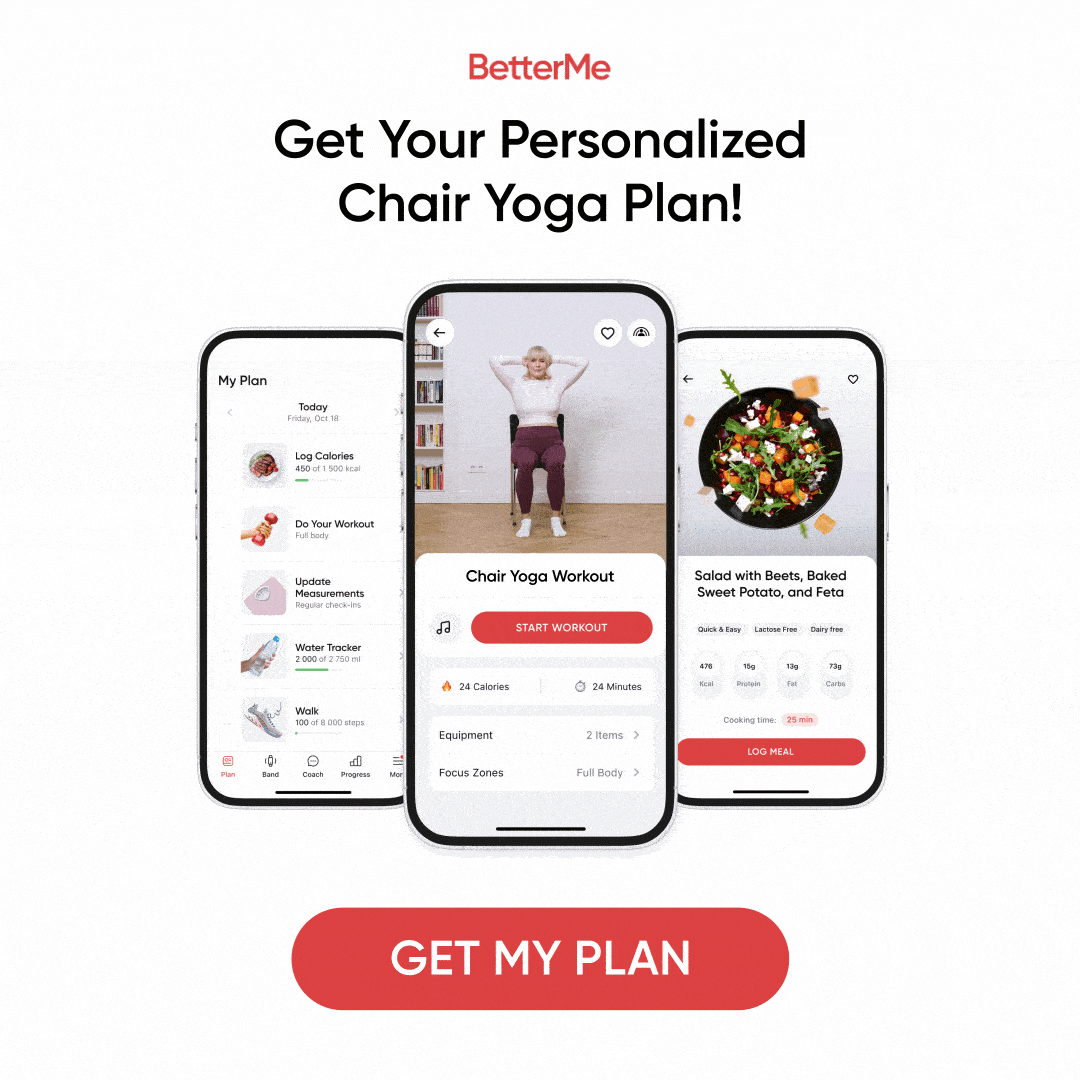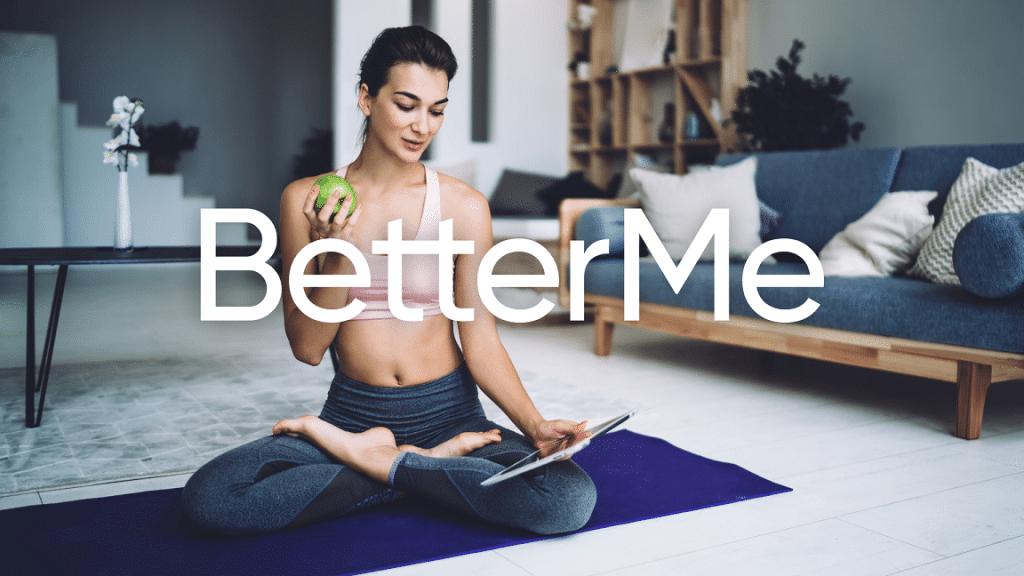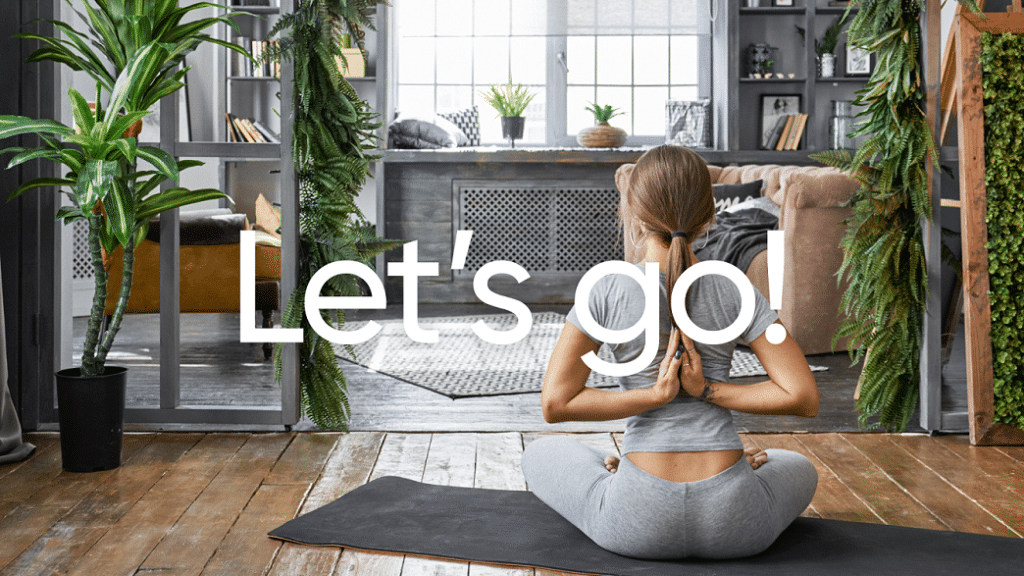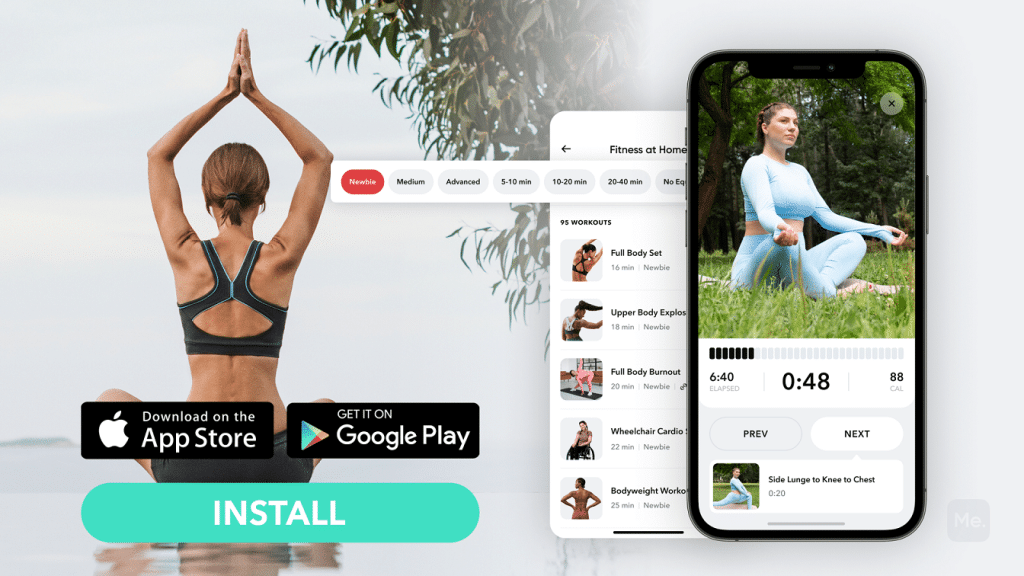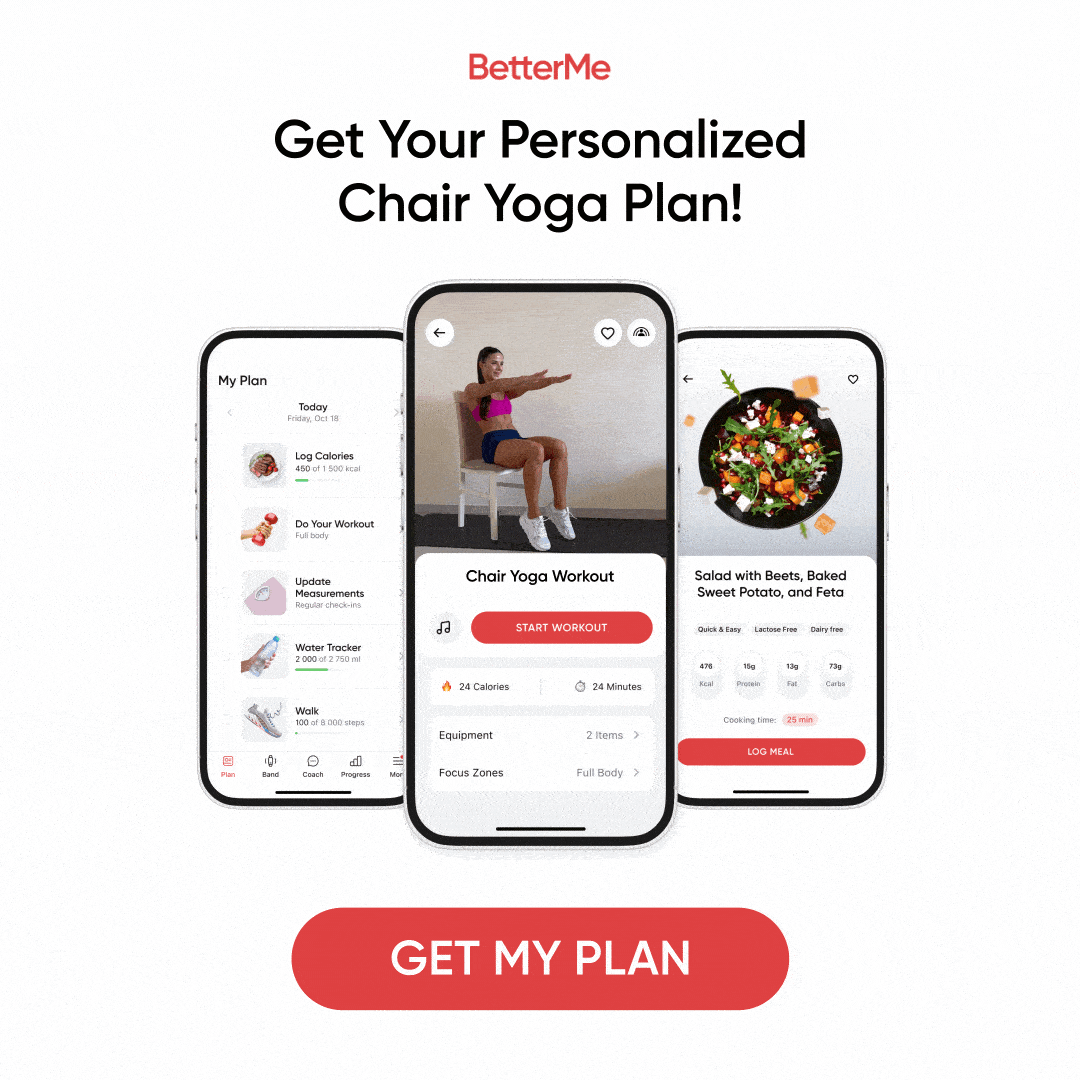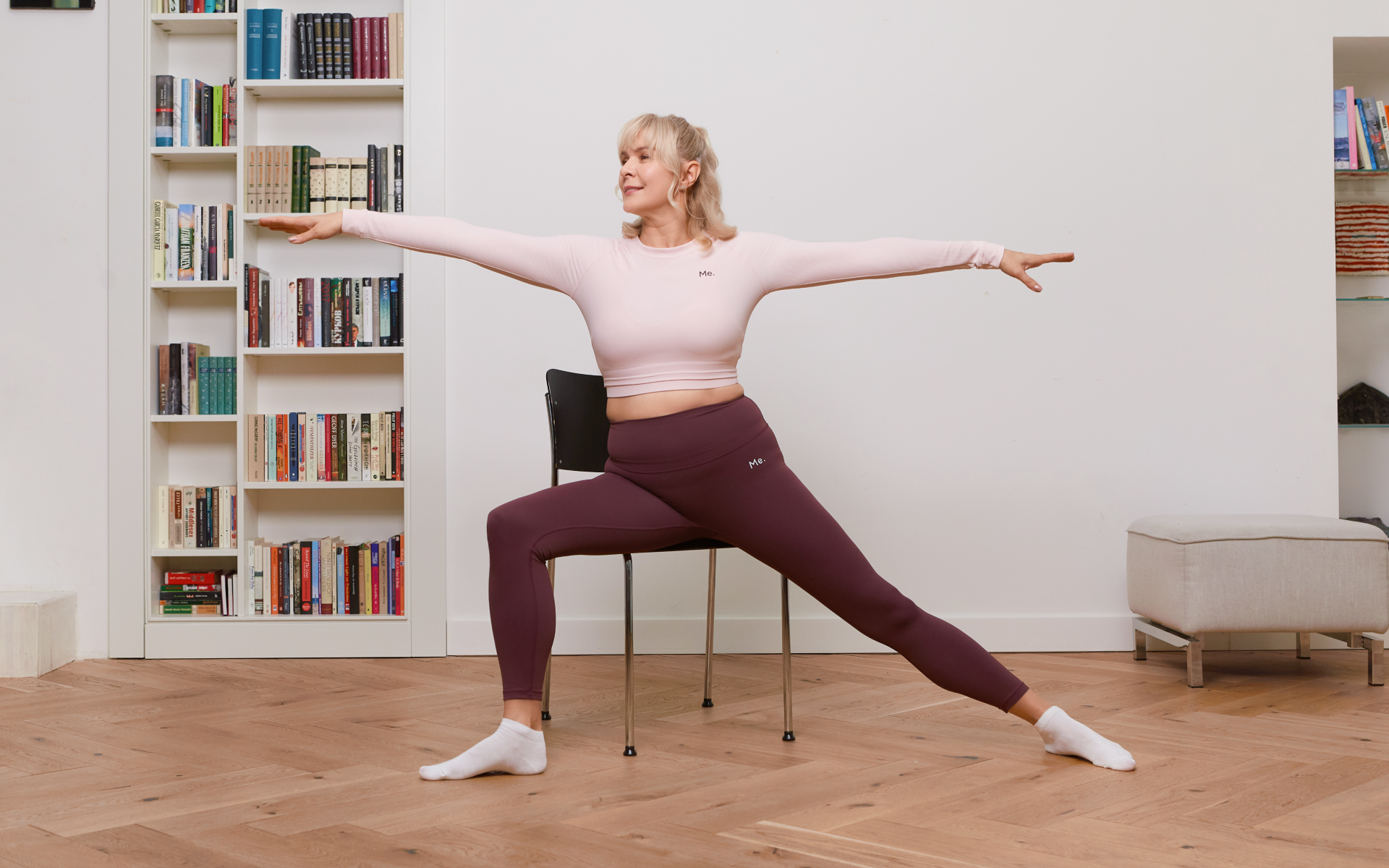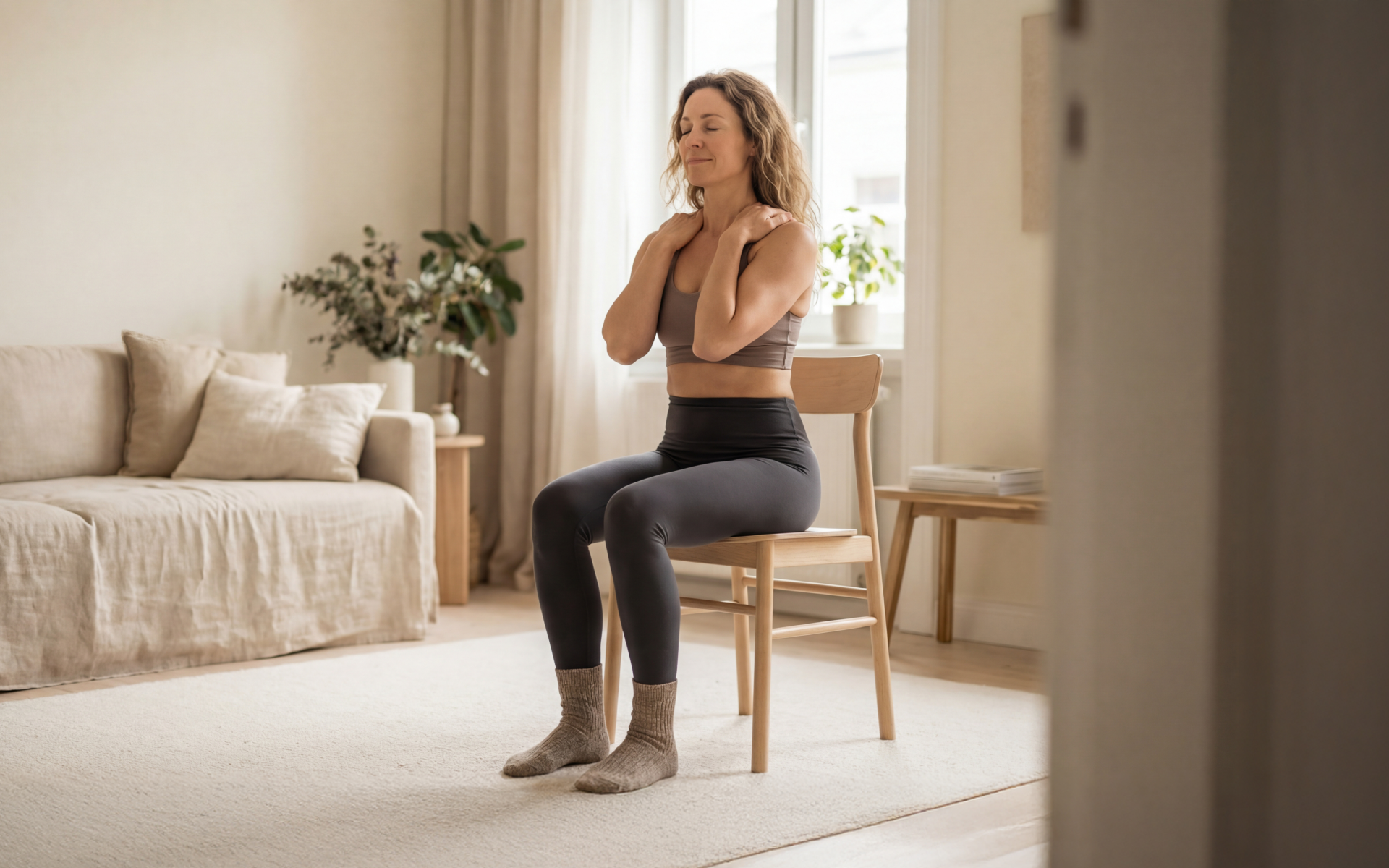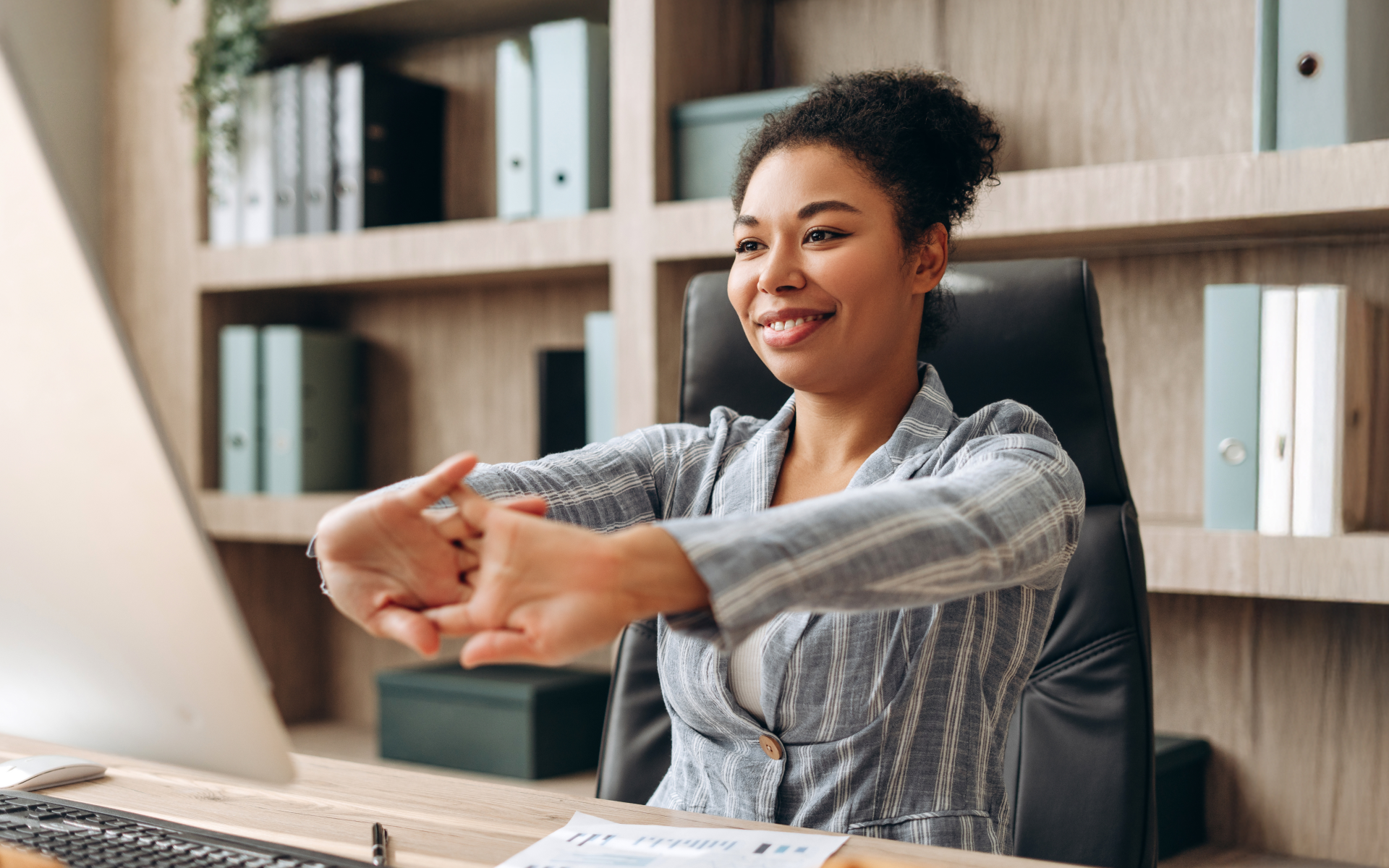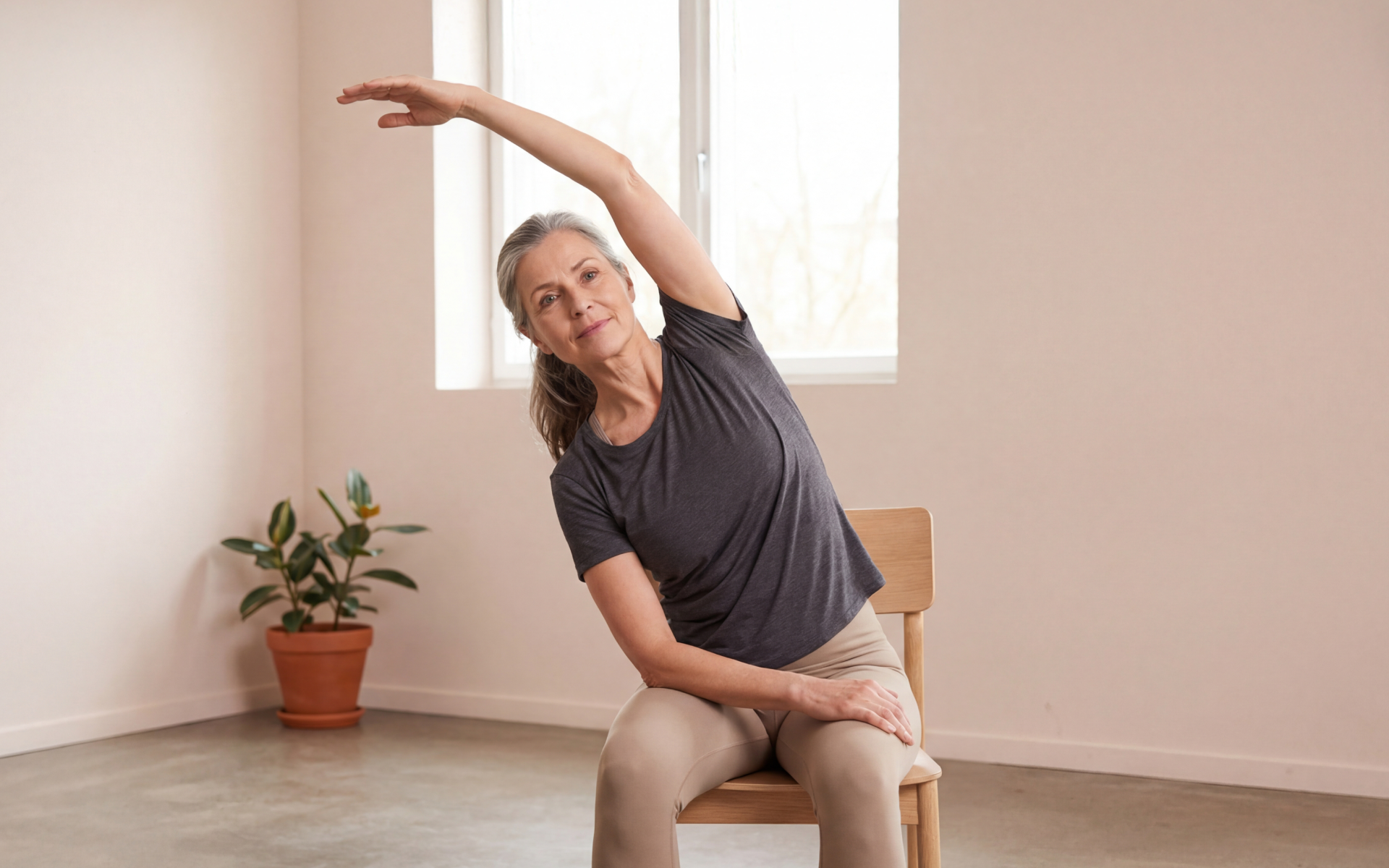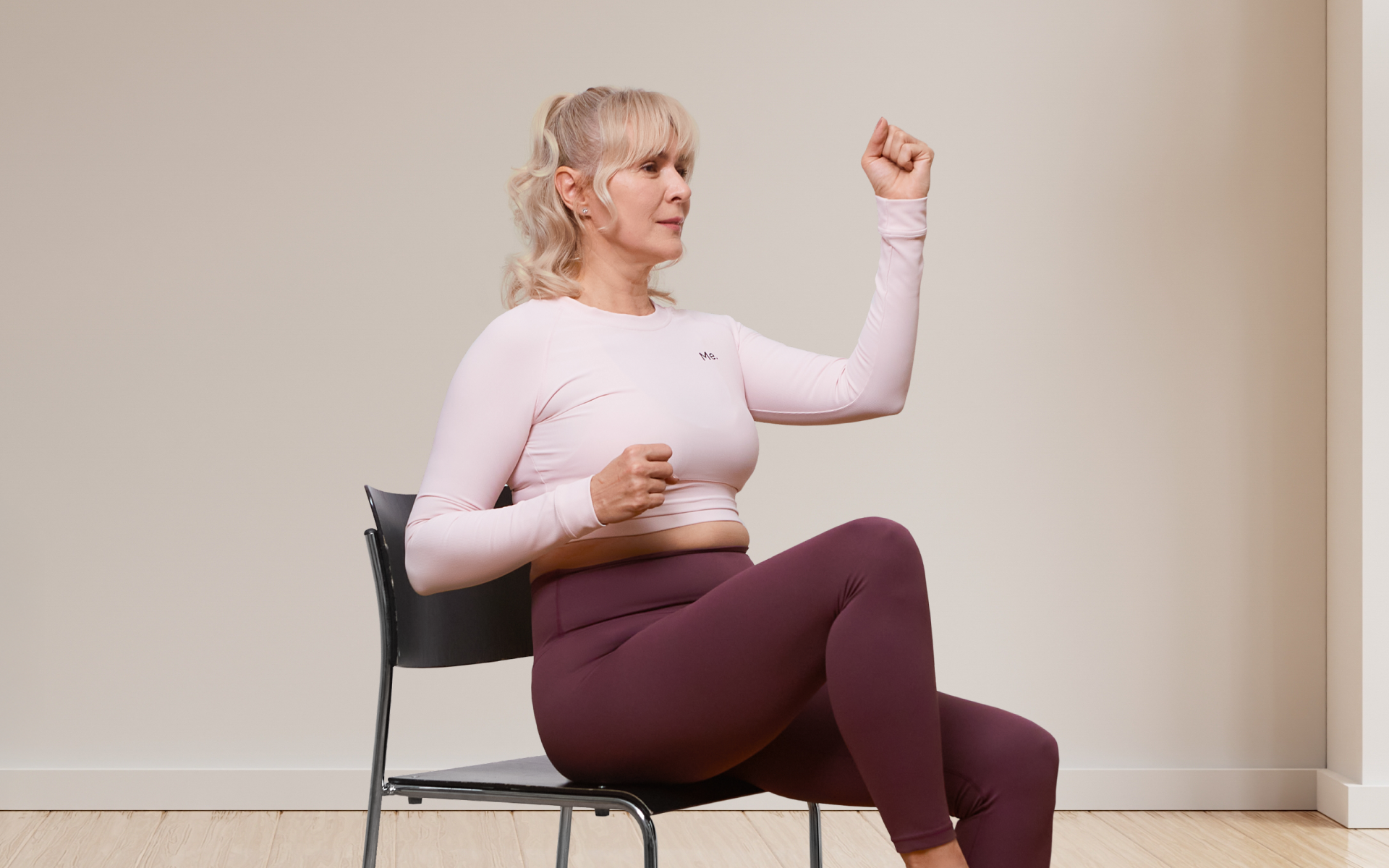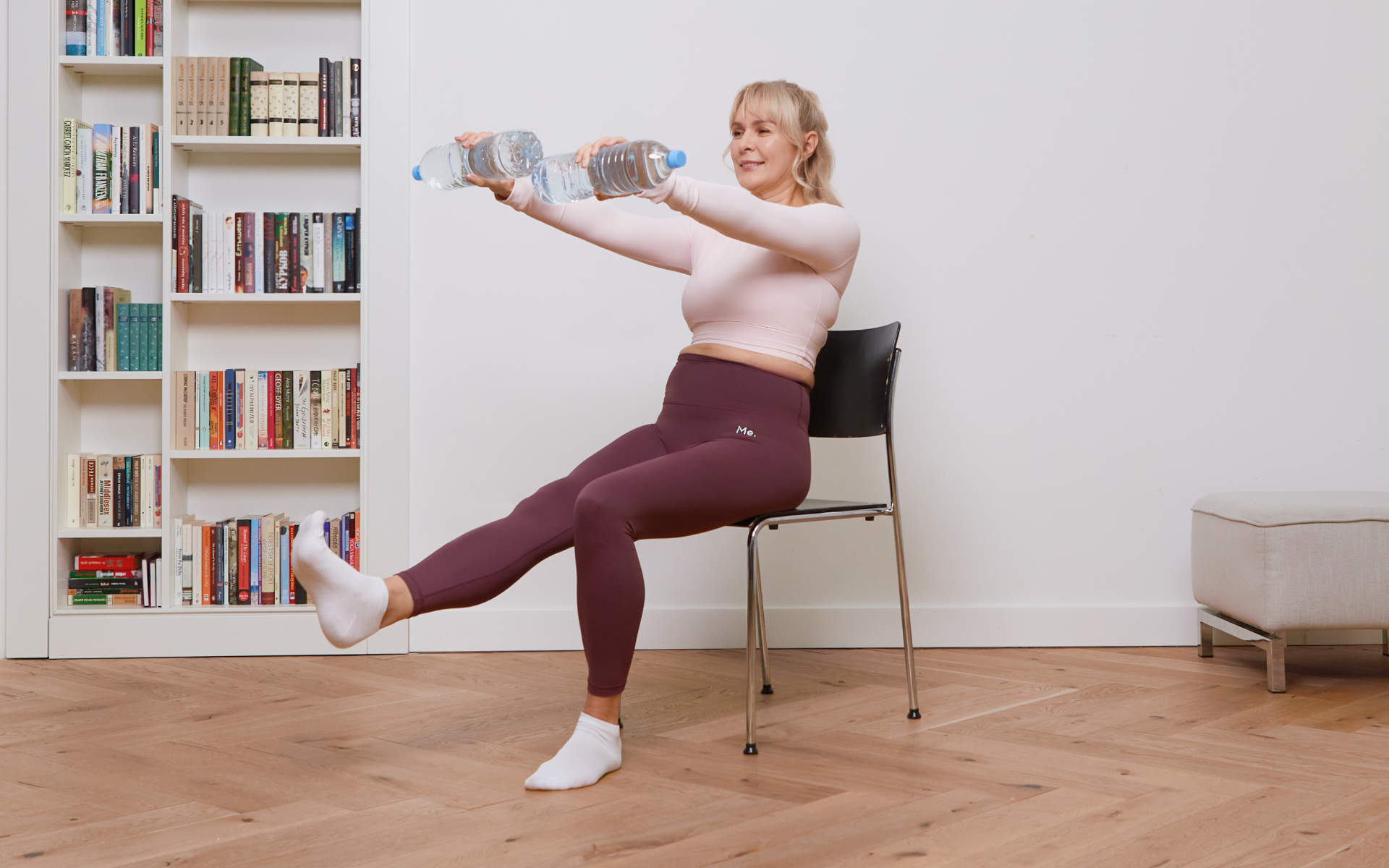As we age it becomes increasingly important to maintain our strength, flexibility, and balance. While regular yoga practice can help with this, as not everyone is able to participate in a traditional class. Chair yoga is a type of yoga that can be done while seated in a chair or standing using a chair for support. It works for seniors who may have mobility challenges or those who simply want to try a gentler form of yoga. It’s also a great way to stay active during the colder months when it’s difficult to get outside (2). Here are 10 chair yoga poses for seniors that can help improve strength, flexibility, and balance. Remember to listen to your body and only do what feels comfortable.
1. Seated Overhead Stretch
The seated overhead stretch targets the deltoids, obliques, and latissimus dorsi. These are muscles that help with everyday activities such as reaching, lifting, and twisting.
To do the seated overhead stretch:
- Sit tall in a chair with your feet flat on the floor.
- Reach your arms overhead, interlacing your fingers.
- Gently pull your arms back until you feel a stretch in your shoulders and sides.
- Hold for 5–10 breaths before returning to the starting position.
2. Seated Neck Stretch
The seated neck stretch targets the trapezius, levator scapulae, and sternocleidomastoid muscles. These are the muscles that support your head and neck. By stretching them, you can help relieve tension headaches and neck pain (2).
To do the seated neck stretch:
- Sit tall in a chair with your feet flat on the floor.Place your right hand on your left shoulder.
- Gently pull your head to the right until you feel a stretch in the left side of your neck.
- Hold for 5–10 breaths before repeating on the other side.
Read More: Bikram Yoga Poses: The 26 Asanas Explained
3. Seated Chest Opener
The seated chest opener targets the pectorals and anterior deltoids. These muscles help with activities such as reaching, hugging, and pushing. Stretching them can help relieve tension in the chest and shoulders. It can also decrease breathing difficulties and improve posture (2).
To do the seated chest opener:
- Sit tall in a chair with your feet flat on the floor.
- Place your hands behind you on the chair seat, fingers pointing towards your body.
- Gently lean back until you feel a stretch in your chest and shoulders.
- Hold for 5–10 breaths before returning to the starting position.
4. Seated Twist
The seated twist targets the obliques, Quadratus lumborum, and erector spinae. These are muscles that help with everyday activities such as twisting, bending, and standing up from a chair. Stretching them can help improve your range of motion and relieve lower back pain (2).
To do the seated twist:
- Sit tall in a chair with your feet flat on the floor.
- Place your right hand on the back of the chair seat.
- Twist your torso to the right, placing your left hand on your right knee.
- Gently twist until you feel a stretch in your sides.
- Hold for 5–10 breaths before repeating on the other side.
If you wish to cinch your waist, tone up your bat wings, blast away the muffin top – our fitness app was created to cater to all your needs! BetterMe won’t give excess weight a chance!
5. Seated Pigeon Pose
The seated pigeon pose is a hip opener that targets the gluteus medius, gluteus Maximus, and piriformis. These are muscles that help with everyday activities such as walking, climbing stairs, and getting in and out of a chair. Stretching them can help relieve lower back pain and improve range of motion in the hips (2).
To do the seated pigeon pose:
- Sit tall in a chair with your feet flat on the floor.
- Cross your right ankle over your left knee.
- Gently press down on your right knee until you feel a stretch in your right hip.
- Hold for 5–10 breaths before repeating on the other side.
6. Seated Forward Bend
The seated forward bend targets the hamstrings and lower back. These are muscles that help with everyday activities such as walking, climbing stairs, and sitting up from a lying position. Stretching them can help relieve lower back pain and improve range of motion in the hips and hamstrings (2).
To do the seated forward bend:
- Sit tall in a chair with your feet flat on the floor.
- Hinge at your hips and lean forward, reaching your hands towards your toes.
- Stop when you feel a stretch in your hamstrings.
- Hold for 5–10 breaths before returning to the starting position.
7. Seated Cat-Cow Stretch
The seated cat-cow stretch is a spine opener that targets the erector spinae and the muscles in between the shoulder blades. This stretch can help relieve tension headaches and neck pain. It can also improve your posture (2).
To do the seated cat-cow stretch:
- Sit tall in a chair with your feet flat on the floor.
- Place your hands on your knees.
- As you inhale, arch your back and look up towards the ceiling.
- As you exhale, round your back and tuck your chin towards your chest.
- Repeat 5–10 times.
Read More: Chair Yoga Poses To Help You De-Stress
8. Seated Eagle Pose
The seated eagle pose is great for stretching the rotator cuff muscles. These are muscles that help with overhead activities such as reaching, throwing, and lifting. Stretching them can help improve arm circulation and range of motion (2).
To do the seated eagle pose:
- Sit tall in a chair with your feet flat on the floor.
- Raise your right arm and thread it under your left.
- Cross your forearms in front of your chest and clasp your hands together.
- Gently press your elbows together until you feel a stretch in your shoulders.
- Hold for 5–10 breaths before repeating on the other side.
9. Seated Mountain Pose
The seated mountain pose is a great way to lengthen the spine and relax the body. This stretch can help improve your posture and ease back pain (2).
To do the seated mountain pose:
- Sit tall in a chair with your feet flat on the floor.
- Place your hands on your knees.
- Inhale and lengthen your spine.
- Exhale and round your back, tucking your chin towards your chest.
- Repeat 5–10 times.
BetterMe is your fast-track ticket to a long-lasting weight loss! Tailor your fitness journey and maximize your results with just a couple of swipes!
10. Seated Warrior Pose
The seated warrior pose is a balance pose that targets the muscles in the legs and core. This pose can help improve your balance and coordination (2).
To do the seated warrior pose:
- Sit tall in a chair with your feet flat on the floor.
- Stretch your arms out to the sides at shoulder height.
- Slowly raise your arms overhead and clasp your hands together.
- Hold for 5–10 breaths before repeating on the other side.
The Bottom Line
Chair yoga is a great way for seniors to stay active and improve their strength, flexibility, and balance. These 10 poses can help you get started. Remember to listen to your body and only do what feels comfortable. If you have any pain or injuries, please consult your doctor before practicing yoga.
DISCLAIMER:
This article is intended for general informational purposes only and does not serve to address individual circumstances. It is not a substitute for professional advice or help and should not be relied on for making any kind of decision-making. Any action taken as a direct or indirect result of the information in this article is entirely at your own risk and is your sole responsibility.
BetterMe, its content staff, and its medical advisors accept no responsibility for inaccuracies, errors, misstatements, inconsistencies, or omissions and specifically disclaim any liability, loss or risk, personal, professional or otherwise, which may be incurred as a consequence, directly or indirectly, of the use and/or application of any content.
You should always seek the advice of your physician or other qualified health provider with any questions you may have regarding a medical condition or your specific situation. Never disregard professional medical advice or delay seeking it because of BetterMe content. If you suspect or think you may have a medical emergency, call your doctor.
SOURCES:
- Chair Yoga and Why Seated Yoga Poses Are Good For You (2021, lifespan.org)
- The Effect of Chair-Based Exercise on Physical Function in Older Adults: (2021, nih.gov)

